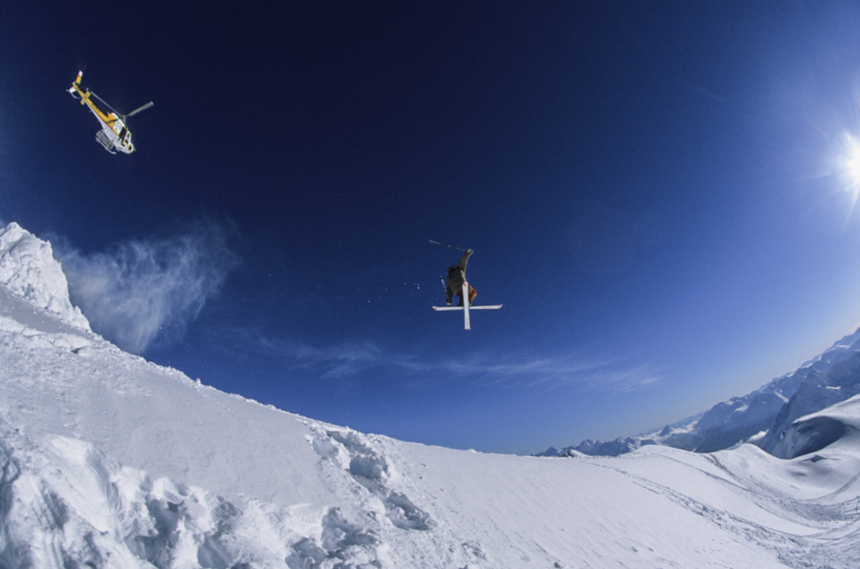 Airing it out beneath the heli. TGR Archive photo.
Airing it out beneath the heli. TGR Archive photo.
Chet Simmons fires his pistol into the pale blue morning sky as skiers scramble to score one of the four coveted spots in his Bell Jet Ranger.
“Who wants to go to a mountain top?”
Fifteen minutes later, the helicopter, bursting with testosterone and neon outerwear, lands precariously on top one of the monstrous Alaskan peaks soaring over Thompson Pass. Skiers pile out, rearing to rip another first descent down a gravity-defying, 4,000-foot line.
Thompson Pass is 30 miles east of Valdez, a bumpy, blown-out ride up the Richardson Highway, a gateway straight into the heart of the Chugach. Daunting peaks slice through the Alaskan sky, the glaciers are a never-ending sea of white that stretches as far back as the eye can see. The maritime snowpack causes snow to cling to near vertical spines and ridges, unfathomably steep terrain that would make even the most experienced skiers knees go weak. “Stuff so steep, you can’t even comprehend how snow sticks to it,” describes Kevin Quinn, owner of Points North Heli.
The dozen or so skiers on Thompson Pass in the early 90s were the only skiers in the entire 250-mile range, flying to the top of unnamed peaks to lay tracks down corners of the earth that no man had been—much less skied—before.
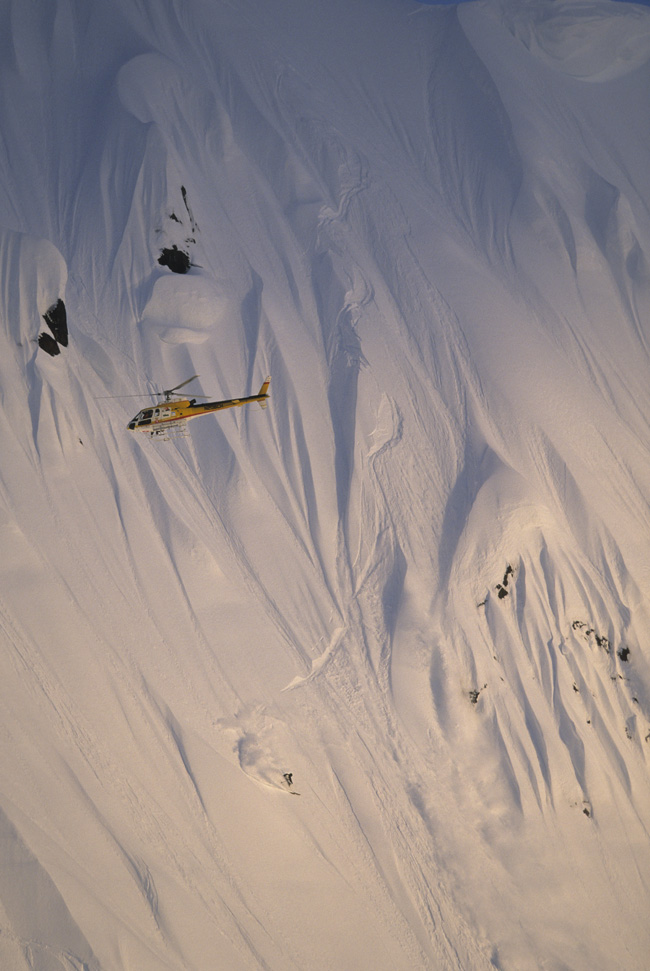 The Chugach is where dreams come true. TGR Archive photo.
The Chugach is where dreams come true. TGR Archive photo.
Simmons was a pistol-packing Vietnam vet who wore a thick mustache and championed a fearless and daring attitude—after getting shot down in Vietnam 13 times, not much could intimidate him. He had no problem confronting risk and was known to make impossibly precise landings on cramped mountain tops. If anyone held their skis straight up while he was trying to fly away he’d pull out his pistol and shoot at their feet as a reminder to get out of his way.
“It was the Wild West back then,” Quinn recalls. “Pure chaos. Everyone scrambling to get a flight out, hoping you get in with someone you know. No one has any idea what’s going on and then all the sudden you’re way out there.”
Skiers were lucky to nab a $25 seat in Simmons’ chopper, and once they unloaded they were entirely on their own. “There were really no rules,” Simmons laughed in a 2001 interview with Tailgate Alaska. “I’d drop ya off and hopefully you can take care of yourself, I don’t really care though. Maybe I’ll remember to pick you up somewhere when you’re done.”
The reason that Valdez is practically a household name among skiers traces back to Coloradan Mike Cozad, who originally moved up to Valdez to work as a commercial fisherman in the 80s. After a flight in Chuck McMahon’s Super Cub bush plane in the spring of 1987, Cozad and McMahon agreed that the Chugach was ripe for the picking. “I figured we oughta get something going with skiers out here,” McMahon remembers in TGR’s 2012 film The Dream Factory.
In 1988 Cozad purchased the Tsaina Lodge on Thompson Pass, an old roadhouse for oil truckers built in 1949, and hatched the idea of an extreme skiing competition to kickstart business. With the support of the town of Valdez, the first annual World Extreme Skiing Championships (WESC) was set to take place in the spring of 1991. Jim Conway, Seth Morrison, Jeff Zell, and Doug Coombs were a few of the invitees who would ultimately play a huge part in the birth of heli skiing in the Chugach.
The mayor of Valdez showed up to the Tsaina in late April along with half the town’s curious but skeptical residents. Mike Hattrup, Scot Schmidt, and Glen Plake flew in to be celebrity judges, and Doug Coombs emerged the first World Extreme Skiing Champion.
The pandemonium was irresistible, and by the early 90s, skiers from all over the world began to flock to the Chugach to put their skills to the test.
Virtually overnight, Valdez transformed from a sleepy port town best known for the infamous ‘89 Exxon Valdez oil spill, to the mecca of extreme skiing—somewhere any dedicated skier would hopefully make a pilgrimage. “It was the next big thing, all the sudden everyone wanted a piece of it,” said Quinn.
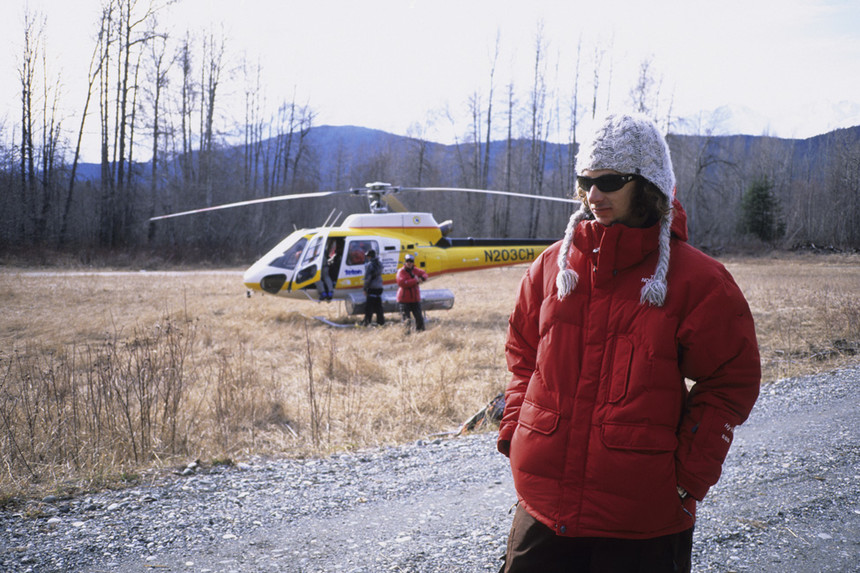 A young Sage Cattabriga-Alosa contemplating his first tastes of Alaskan heliskiing. TGR Archive photo.
A young Sage Cattabriga-Alosa contemplating his first tastes of Alaskan heliskiing. TGR Archive photo.
Extreme Goes Mainstream
Doug Coombs pioneered the commercial heli ski industry in Alaska when he opened Valdez Heli Ski Guides in 1993. At the time, bringing clients up and flying them around was novel, practically unheard of. “I thought it was a ridiculous idea at the time,” admitted Scott Raynor, who later bought VHSG from Doug in 2000. “Just totally unrealistic. And dangerous.”
By 1998 there were four commercial operations in the Chugach, flying skiers to the top of peaks they had only ever seen in the movies.
TGR co-founders Todd and Steve Jones were among the bright-eyed young skiers who joined Coombs’ repertoire of VHSG guides in the early 90s. The Jones brothers were living in Jackson Hole and had moved up to Valdez in the summers to commercially fish. They started guiding for Doug in the spring to make ends meet, scraped together enough cash to buy a 16-millimeter film camera, and began to document the unfathomable first descents that Coombs was pointing his skis down. The Continuum, TGR’s first film, released in 1996, gave the public another taste of the massive terrain waiting for them in the Chugach.
During the years of WESC, the scene in Valdez was not for the faint of heart. There were no frills, no guides to hold your hand. It was every man for himself and living in shameless squalor was part of the fun. The intimidating Chugach terrain pushed the sport to a new level as some of the world’s best skiers fed off each other’s frenzied excitement. “We used to say if it it doesn’t stick out on the horizon, it wasn’t worth skiing,” Quinn laughs.
Down days were hard on the liver, and the never-ending party at the Tsaina was akin to that of a frat house, ski bums passed out under the pool table or firing rounds off the back porch. “For the first five to 10 years it was all your local hot shots at Jackson and Squaw, flocking to Alaska because that was the next big thing,” remembers Quinn.
When Quinn started Points North Heli in 1998, he wanted to show people that there was something for everyone, not just the extreme skier. “Between all the gnarly lines there are shoulders and ridgelines, mellow terrain that most competent skiers could ski.”
Gradually a new clientele emerged in Valdez. Wealthier folks started to roll in and operations fell into a high-end stride. Catered meals, deluxe lodges, and wood-fired saunas started to edge out the unfiltered chaos that Doug Coombs had championed on Thompson Pass. The wild, untouched peaks of Alaska’s Chugach range were slowly opening their doors to recreational skiers.
“The guiding operations allowed people from all walks of life to come up and live out their Alaskan dream,” Quinn says of the transition. “It’s still tough terrain, you’re going to challenge yourself a lot, but we figured out how to make it more inviting for those who don’t make a living at this.”
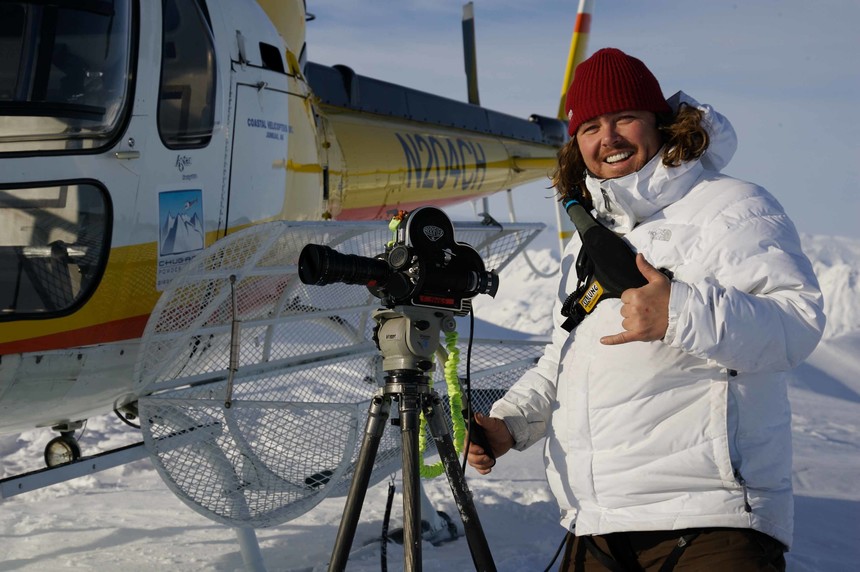 Todd Jones prepping the rig. TGR Archive photo.
Todd Jones prepping the rig. TGR Archive photo.
Trouble in Paradise
Business was booming on Thompson Pass in the late 90s but as skiers poured in from around the world, guide outfits inevitably started to bump into each other in the field. “There was a lot of bad blood between the operators in the early days,” remembers Raynor. “You’ve got all these guys, alpha male types, running operations and we got pretty competitive.”
In the early days it wouldn’t be uncommon to get to a run and find that another heli had landed there first—guides wanted to get their clients on the best runs without flying too far out. “You make the most money flying close to home because of fuel,” says Don Sharaf, a VHSG guide since 2001. The terrain behind the Tsaina Lodge on Thompson Pass is state land, meaning no permits are required to fly clients there. Sharaf says that generally operators stay away from zones that are within a two to three minute flight from someone else’s base, but there aren’t any guarantees. “It’s generally respected to give each other that space but there aren’t any written rules. As you get further out it just gets more and more competitive.”
Raynor says “when the weather was good it was a little easier for companies to stay out of each other’s way, but with challenging conditions, everyone is trying to ski the same terrain and it’s scarce.” Still, he says tensions have smoothed out quite a bit in recent years. “We’ve all grown up, we’re older, more patient. We work together a lot more.”
Safety regulations have played a big part in alleviating tension between guiding operations in Valdez. Sharaf worked as the avalanche forecaster for VHSG for almost two decades and noticed that “while the owners rarely got along well, there was usually a solid line of communication between the forecasters.” Sharaf says they share snow conditions, observations, and avalanche reports. Raynor adds that now a lot of companies share the same radio frequencies so they can stay out of each other’s way.
“Back in the day we were all just professional ski bums, trying to make a living at this,” says Quinn who is the former president of the US Heli Ski Association. “Now it’s way more buttoned up with safety standards and guide training. It’s a real professional operation.”
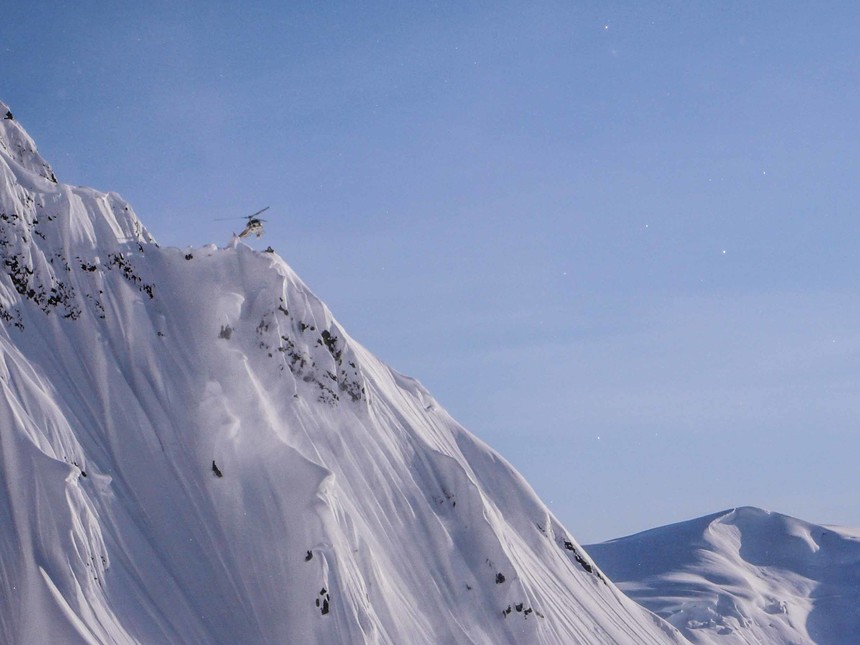 Dropping into a fairytale. TGR Archive photo.
Dropping into a fairytale. TGR Archive photo.
The Heli Ski US Association now sets the standards for many heli ski operators in the United States. Members of HSUS all comply with the same practices, guide standards, and performance reviews as well as going through routine audits. HSUS trains aspiring heli guides, works with members on emergency protocol and avalanche training, and serves as a resource to educate members of the industry. Raynor says it has brought a lot of companies together—safety is something everyone can agree on.
The tech advancement of helicopters has made it much easier for outfits to stay out of each other’s way as well, opening up new runs to give the guides more options. “We used to fly A-Star B2s, now we fly B3Es which are much more powerful and precise,” Raynor explains. “Tighter landings let you get to a lot of peaks that were off-limits before. Now we’re skiing lines you never would have thought of skiing back then. We have way more to choose from.”
Quinn agrees that there’s way more terrain accessible to them than there was 10 years ago. “We’re still opening up new runs each season, each year it looks a little different than it did before. There’s always more out there.”
Most operations have adopted smaller group sizes which allow them to fly deeper into the Chugach. Less weight in the helicopter maximizes fuel efficiency, allowing groups to go out all day without having to go back to the lodge to refuel. Raynor says that back in the 90s the standard was two groups of four skiers, whereas now they’ll fly one group of three skiers. “It lets us get way way out there now,” says Raynor. “You can go really really deep and you won’t see anyone.”
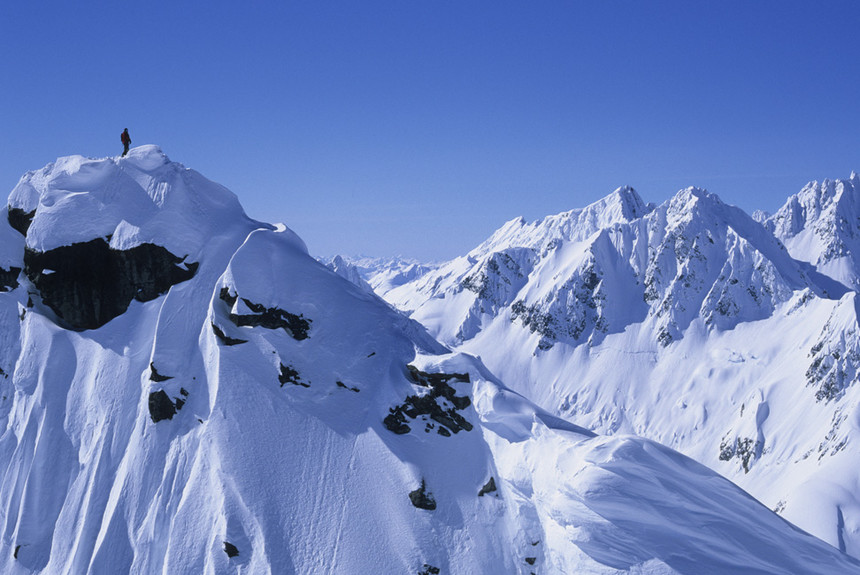 Looking into the future, Alaskan heli ski ops see the challenges they will face. TGR Archive photo.
Looking into the future, Alaskan heli ski ops see the challenges they will face. TGR Archive photo.
Times Are A Changin'
Although relations have improved between guide outfits, the recent influx of snow machines and ski tourers is now stepping on the toes of heli operations on Thompson Pass. “We don’t run into ski tourers as much because they just can’t get as far,” Sharaf explains. “It’s the sled-powered skiers who are becoming the problem for us—they go in, set up basecamp in areas that are as far as a 10 to 15 minute flight.”
Sharaf says the protocol is to give skiers at least one run of distance and to never ski above them. “But usually we’ll give them the whole ridgeline and go somewhere else because clients are paying to ski where there’s no one else.”
“It makes it tough for us from an operational and an economic standpoint,” he adds. “We end up flying further which costs more in fuel, and it’s harder to guide because you constantly have to change your plan.”
The low-hanging fruit behind the Tsaina is enticing for foot-powered skiers due to the short approach. “It’s the best place if you’re on foot because you’ve got these 1,500 to 2,000-foot couloirs, easy to get up in a day,” Raynor says. “But other than that, the Chugach isn’t really a great place to be a ski tourer. It’s not like the Wasatch where you get massive relief right off the bat. You might walk three, four hours just to get to the base of a line out here. It’s just really, really big—that’s why we fly.”
Quinn is confident that despite the growing popularity of ski touring and other mechanized travel, there will never be a substitute for a heli drop. “People are always going to want that magic carpet ride up to a mountain top. That I know for sure.”
The scene on Thompson Pass may seem a far cry from the rugged elite that jockeyed for a ride in Chet Simmons’ Bell 206 almost 30 years ago, but the same thirst for exploration and adventure that inspired Mike Cozad and Doug Coombs hasn’t wavered. “The Chugach is the Super Bowl of heli skiing, Disneyland for adults,” Quinn says. “Nothing will ever change that.”



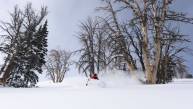
_image_by_travis_rousseau___video_thumb.jpeg)

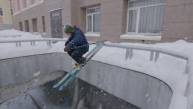

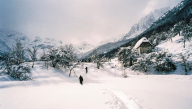

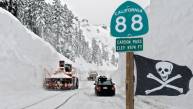
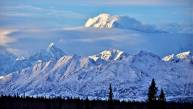
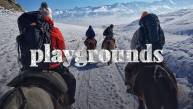

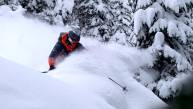
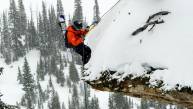
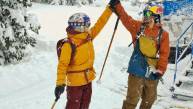
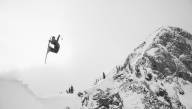

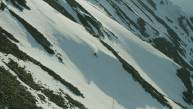
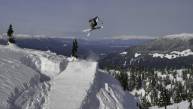

__video_thumb.jpg)
travelingskier
December 15th, 2018
How is Dean Cummings not in this article? Shame.
Tania
December 18th, 2018
Its amazing… wish a very happy new year
Tania
December 18th, 2018
Want to see some Christmas funny memes
Rohit11325
October 1st, 2019
https://christmass.net/
Alax John
November 12th, 2019
Hello everyone, Christmas is on his way as everyone is waiting to celebrate with joy and happiness. On this lovely day we have to share good vibes with our loved ones in the way of messages, images, quotes and GIF’s on whatsapp and facebook. Now days memes are in trend so here we can also share some memes on christmas with our friends and relatives We can update our Wallpapers of Mobile and Desktop.
m3732f
December 11th, 2019
Greate post. Keep posting such kind of info on your page. I am really impressed by your blog.
https://wishingsimages.com/merry-christmas-images/